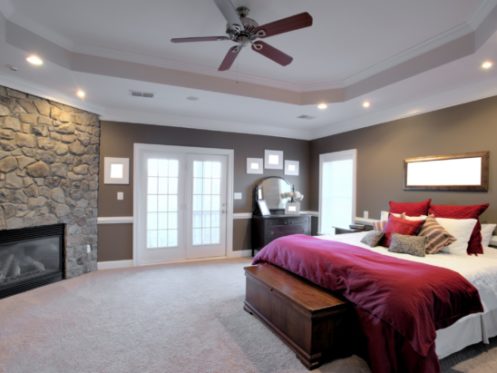Purchasing a home with high ceilings will give you the benefit of an open, airy environment. Even as you add furnishings, artwork, and other indoor decor, you’ll find that it’s virtually impossible to make your living space feel cluttered. High ceilings additionally give homes a decidedly luxurious look and fill them with ample light. However, for all their benefits, elevated ceilings can also negatively affect how your air conditioner works. Understanding the impact that your ceiling height has on your cooling system is the first step in mitigating its effects. Thus, the following are five things that you should bear in mind when choosing and using the AC system in your Tucson, AZ home.
1. Your Air Conditioner’s Cooling Cycles Will Be Longer
When the outdoor temperatures start to rise, your air conditioner’s cooling cycles will lengthen. Although higher ceilings don’t create more usable area, they do create more space that needs to be cooled. Higher ceilings increase the overall volume of rooms, and this means that air conditioners have to work harder to create residents’ preferred indoor temperatures.
Longer cooling cycles invariably result in more energy use and higher home energy bills. They also mean having to wait longer for relief after the cooling system has been turned on. You can address both of these issues by setting a moderate temperature at your thermostat and by using a smart or programmable thermostat rather than a basic, low-thrills option. Programmable and smart thermostats can be used to time AC activities according to your regular schedule. With one of these devices installed, your air conditioner won’t blow out tons of cooled air while you and your family are away at work or school, but it will also kick into action well before you return so that the interior of the building is already comfortable when you arrive.
2. AC Sizes Are More Difficult to Calculate With Higher Ceilings
It’s always important for homeowners to let licensed HVAC technicians choose and install their air conditioners. Buying an air conditioner that’s too large or too small for your home can result in:
- Indoor humidity issues
- Shorter equipment lifespans
- Frequent breakdowns
- Short-cycling
Calculating the amount of space that needs to be serviced becomes tricky with non-traditional ceiling heights. This makes it all the more important that you pass this job on to a professional who understands which factors to consider. Buying an air conditioner that has the right capacity for your living environment will keep your energy bills at a moderate, manageable level, prevent excess wear, and ensure that your home always feels comfortable.
3. You’ll Need a Multi-Pronged Cooling Plan
The best cooling plans for every home are always multi-pronged. This is especially true when cost control and efficiency are major concerns. These plans start by creating a tight home envelope through various efficiency measures like:
- Insulating HVAC ductwork
- Adding attic insulation with higher R values
- Upgrading to multi-pane windows
- Adding weatherstripping to windows and doors
Taking these and other steps in your home will minimize air loss. This way, although you’ll be paying a bit more money to cool down extra space, you won’t be paying additional money for wasted energy. Your multi-pronged cooling plan can additionally include ceiling fans, light-blocking blinds, and other elements.
4. More Thermal Heat Gains
Homes that have higher ceilings often have larger windows, more windows, or decorative skylights. These design features are commonly added to create balance. Although they’re aesthetically pleasing, they can and often do contribute to greater thermal heat gains. Having rooms that feel light and airy may be good during the cooler months of the year, but when sweltering temperatures arise, they can create an environment that’s downright unsafe. Worse still, many decorative and oversized windows aren’t given optimum window treatments. If you can, choose light-blocking curtains and blinds that are adaptable. This way, you can let natural light flow in when outdoor temperatures are moderate, but you can also reliably block solar heat on days when thermal gains make a major difference.
5. Humidity Control May Prove More Challenging
Nothing is worse than hot, heavy air that won’t move. One of the greatest and most common misconceptions about humid indoor air is that it’s denser than dry air and will move down to ground level. According to this school of thought, humid air will always travel to the lowest lying areas of a home, where it can be released outdoors via basement vents or other built-in exits.
In reality, humid air is less dense than dry air and has a tendency to rise. Although this might not seem like a major issue if you happen to live in a fairly arid region, it can be problematic if you have lots of building residents taking hot, steamy baths or showers, cooking food, or engaging in other indoor activities that generate moisture.
While air conditioners are largely valued for their ability to cool indoor spaces down, they also have the incredibly important responsibility of regulating indoor humidity. Most AC models are built for homes that have standard eight-foot ceilings. In homes with ceilings that are 12 feet high or taller, there’s a lot more space to dehumidify, and a lot of this space is well above building residents. This increases the amount of strain on air conditioners and may leave homes feeling overly moist.
Although there are strategies that homeowners can use to shorten cooling cycles in homes that have elevated ceilings, shorter cooling cycles might not be ideal. Shorter cooling cycles do cut home energy costs and expedite relief, but they don’t give air conditioners adequate time to extract excess humidity.
In certain homes, having dehumidification equipment could prove necessary. Maintaining balanced levels of indoor humidity is important for preventing mold and mildew growth, ensuring an acceptably high indoor air quality (IAQ), and protecting building materials. Working with a licensed HVAC technician will help you arrive at the right combination of integrated HVAC accessories for ensuring balanced humidity, curbing your energy bill, and limiting AC stress.
Several Ways to Optimize Your AC System’s Performance With High Ceilings
There are several easy ways to offset the impact that your elevated ceilings have on your air conditioner’s performance. These include:
- Installing ceiling fans and using them correctly
- Properly ventilating your attic
- Having adequate attic insulation
- Installing your AC condenser in a strategic location
- Choosing the right air conditioner capacity
When set to spin counterclockwise in summer, ceiling fans will push cool air down to create a comfortable breeze. With 10 or 12-foot ceilings, these fixtures work best when they’re installed on extension rods that place them just eight feet above the floor. Putting your condenser in a shaded location will keep it from overheating, even when it’s subjected to the additional stress of cooling a larger area.
With high ceilings, nothing is more important than getting an air conditioner with the right size and capacity. However, there may be a number of location-specific challenges that must be mitigated. From regulating indoor humidity to mitigating thermal heat gains from larger than average windows, you’ll definitely want a multi-dimensional cooling plan that’s just as effective for cutting home energy costs as it is for ensuring home comfort.
At Fusion Plumbing & Air, we’re proud to provide exceptional heating and cooling services to residents of Tucson, Arizona. We also offer plumbing, drain cleaning, and sewer jetting services. If you have high ceilings in your home and want help creating the perfect cooling plan, we’ve got you covered. Call us now to find out about our full range of capabilities or to schedule service.




